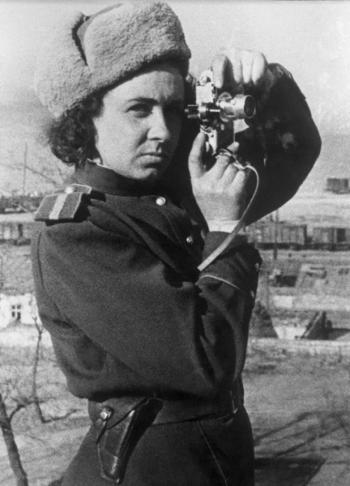Olga Lander was born in 1909 in Samara, in the family of a photographer. From early childhood, she was fascinated with drawing. Therefore, after completing high school, she chose to study at the Moscow State Stroganov Academy of Industrial and Applied Arts. After moving to Moscow and beginning her studies, Olga decided to carry on the family tradition, becoming a student of the famous Moscow photographer Moisei Nappelbaum. She was so fascinated with photography that she quit her studies.
In the early 1930s, Olga Lander traveled extensively in Central Asia, as part of a film unit in which she worked as a photographer.
Lander went on to work at the Komsomolskaya Pravda newspaper. Initially, she was an assistant at a photo lab, but shortly thereafter her talents were recognized, and she became a full-time press photographer.
After the Nazi invasion of the USSR in late June 1941, Olga Lander was evacuated to Tashkent, where she continued to work as a photo reporter. However, she kept writing requests to be sent to the front. In early 1942, she managed to return to Moscow. Shortly thereafter, she was sent to the front as a photographer for the military newspaper Sovetsky Voin. She was one of the few photo reporters who worked continuously on the battlefields, without returning to the editorial offices of the newspapers. She moved with the 3rd Ukrainian Front, covering the major engagements, such as the Battle of Kursk and the fighting in Kiev, Odessa, Romania, Hungary, and Austria. In addition to photographing the military action, Lander also managed to capture snatches of the soldiers' daily life, in the lulls between battles. Throughout this time, the newspaper published more than a thousand photographs by Olga Lander.
Lander met V-E Day in Vienna, having attained the rank of lieutenant. In the course of the war, she was awarded the Order of the Red Star; the Order of the Patriotic War, 2nd class, and some medals.
Olga Lander remained in Soviet-occupied Romania until 1948, as a member of the newspaper's editorial team.
After being discharged from the army, Olga returned to Moscow. She worked for a time in the photo department of the VDNKh (Exhibition of Achievements of the National Economy), and was later a photo reporter for the Sovetskaya Rossiya newspaper, where she worked until 1974.
Olga Lander died in 1996.
More than three thousand negatives by Olga Lander are currently held at the Armed Forces Museum, the Russian State Film and Photo Archive, and the State Historical Museum.
In 2017, the Military Uniform Museum in Moscow held an exhibition titled Olga Lander. The Supplemented Reality of the War.







